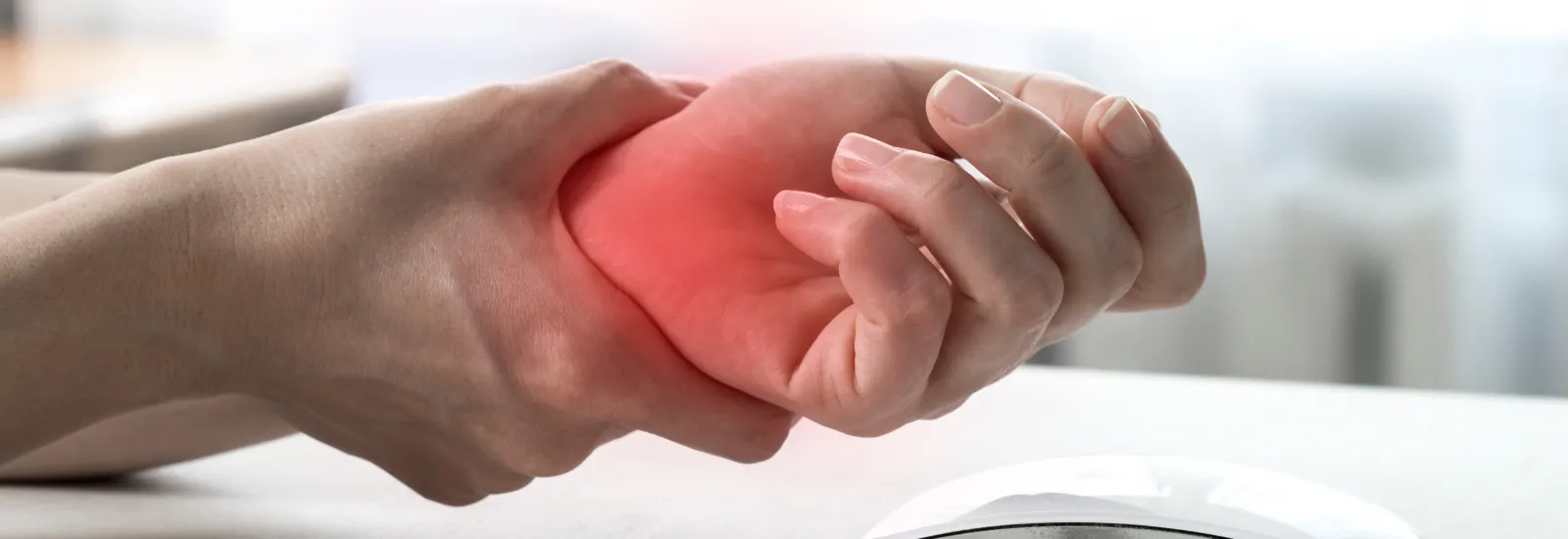
Get relief from carpal tunnel syndrome pain
There are many
treatments available to help manage and treat pain and other symptoms of carpal
tunnel syndrome. Adding a home exercise program to your carpal tunnel treatment
plan may help decrease your frustrating numbness, tingling, burning, or
clumsiness.
What causes carpal tunnel syndrome?
Carpal tunnel syndrome
develops over time, with women more likely to be affected than men. It happens
when the median nerve, which crosses from the arm into the hand, is repeatedly
squeezed or pressed. In this spot, the nerve goes through a narrow passage of
ligaments and bones known as the carpal tunnel.
The carpal tunnel might
be too narrow because of:
- An injury
- A tumor or cyst in the wrist
- Extra fluid in the body
- Infection
- Rheumatoid arthritis or other chronic health conditions
Irritation in the
tissues of the wrist from repetitive movements, like typing or working on an
assembly line, may also cause swelling that makes the carpal tunnel more narrow
than usual. Sometimes the cause is unknown.
Symptoms of carpal tunnel syndrome
Symptoms often start
out mild and worsen over time. Numbness or tingling in one or both hands that
gets worse at night is often the first symptom.
Without treatment,
symptoms usually get worse. You may have numbness and tingling along with:
- A feeling of weakness in the hand
- Clumsiness
- Difficulty making a fist
- Feeling like one or both hands are swollen even if they aren't
- Pain in the hand that may travel up to the elbow
Diagnosing carpal tunnel syndrome
To diagnose carpal
tunnel syndrome, providers use a combination of medical history, physical
examination, tests that check sensation, blood tests, and imaging.
It's important to see
your medical provider as soon as possible after noticing symptoms that might be
caused by carpal tunnel syndrome. Early treatment will help stop future damage
to your median nerve and get you faster relief.
Nonsurgical treatments for carpal tunnel syndrome
Except in the most
severe cases, carpal tunnel syndrome care starts with nonsurgical treatments.
Wearing a wrist splint overnight is often the
first treatment providers recommend. The splint helps relieve pressure on the
nerve by keeping the wrist in a neutral position while you sleep.
Other common treatments
are:
- Acetaminophen or nonsteroidal anti-inflammatory drugs, also known as NSAIDs
- A cortisone injection into the tissue around the carpal tunnel to decrease irritation
- A hot or cold pack on the wrist
- Making changes to how you sit or the tools you use while working
- Osteopathic Manipulative Treatment, a specialized type of hands-on treatment
Though not as common,
regular massage therapy and trigger-point therapy with a massage therapist may
also decrease the severity of symptoms over time.
Other medical
conditions can make the symptoms of carpal tunnel syndrome worse. Treating
other health conditions may help your carpal tunnel syndrome symptoms, too.
Home exercises to decrease carpal tunnel syndrome symptoms
Exercise alone is not
enough to prevent or treat carpal tunnel syndrome, but it may be a helpful
addition to your treatment plan, especially if you have mild to moderate
symptoms.
The most effective
exercises to address carpal tunnel syndrome are stretching, nerve
gliding exercises, and tendon gliding exercises. These can help reduce
pressure and allow the median nerve to move more smoothly through the carpal
tunnel. However, if the median nerve is trapped, exercises could cause
increased pain, irritation, or even injury. It's normal to feel a stretch or
mild pull during exercises, but they should not cause pain.
Exercising the hand and
wrist by squeezing and releasing a ball does not reduce pressure on the nerve,
but it may help decrease symptoms.
Always talk with your
medical provider before starting any new exercise program. Stop exercises and
talk with your provider if you have pain while exercising or if you notice
worsening symptoms.
Surgical treatments for carpal tunnel syndrome
Many people with carpal
tunnel syndrome end up needing carpal tunnel release surgery. This is a common
surgery, and most people go home the same day. It usually involves local or regional anesthesia.
During carpal tunnel
release, the surgeon will cut a ligament (a band of tissue) that goes around
the wrist. This decreases the amount of pressure on the median nerve. Two
different surgeries may be used for carpal tunnel release: open release surgery
or endoscopic surgery.
●
In an open release
surgery,
the surgeon makes an incision (a cut) that is about two inches long running
from the palm of the hand to the wrist. This gives the surgeon a larger open
area to perform the surgery.
●
In endoscopic surgery, one or two small
incisions about a half-inch long each are made in the wrist or palm. A tube
with a tiny camera attached is inserted through an incision. The surgeon uses
the camera to look at the carpal tunnel, median nerve, and other surrounding
tissue. Then a small knife is inserted through the tube to cut the ligament.
If surgery is
recommended, your provider will discuss what type is best for you.
Both types of carpal
tunnel release surgery are successful in most cases, though some remaining
numbness or weakness is common. Many people have decreased symptoms right after
surgery, but full recovery may take months. You will likely need to modify work
or home activities for several weeks after the procedure.
Your provider may also
recommend physical therapy or hand therapy with an
occupational therapist to help you recover after surgery. Both can help you
regain strength and movement in your hand and wrist. An occupational therapist
can also teach you how to modify the things you need to do and recommend
adaptive equipment.
Don't suffer from
carpal tunnel syndrome. Contact Reid Health Orthopedics at

